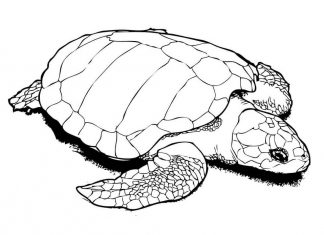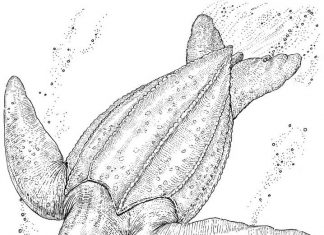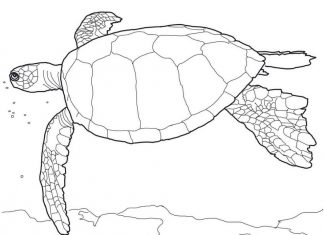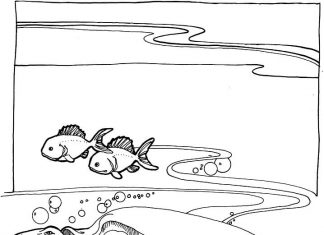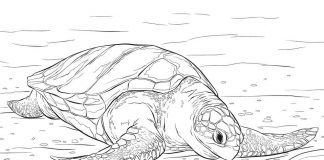Sea turtle is the general name for several species of turtles that spend most of their lives in the seas and oceans. They are aquatic species belonging to the family of sea turtles (Cheloniidae) and dermochelydids (Dermochelyidae). Sea turtles differ from terrestrial and freshwater turtles primarily in the shape and structure of their limbs, which resemble flippers and enable them to move quickly in the water. Sea turtles play an important role in marine ecosystems, helping to control populations of jellyfish and other marine organisms. Unfortunately, many species of sea turtles are now threatened with extinction due to a variety of factors, such as incidental catch, marine pollution, habitat degradation and the illegal trade in eggs and shells.
Sea Turtle Coloring Book
Information
- Species: There are 7 different species of sea turtles: green, leatherback, chinstrap, olive ridley, vulture, carapace and flatback turtle.
- Anatomy: The limbs of sea turtles are transformed into flippers, allowing them to move quickly through the water. The leatherback sea turtle is the only species that does not have a hard, horned shell, but rather a soft, leathery shell.
- Nutrition: The diet of sea turtles varies from species to species. For example, green turtles are mainly herbivorous and feed on algae and sea plants, while karettes are carnivorous and feed mainly on jellyfish and other invertebrates.
- Reproduction: Sea turtles return to land to lay their eggs. Females lay their eggs in pits they have dug on the beach, and after the eggs are laid, they cover them with sand and return to the sea. After a few weeks, the young hatch and head to the sea.
- Migrations: Sea turtles are known for their long migrations between foraging areas and breeding sites. Some species, such as the karetta, can travel thousands of kilometers.
- Life expectancy: Sea turtles can live a very long time, even more than 100 years. However, many sea turtles do not live to maturity due to natural predators and man-made threats.
- Threats: Sea turtles are endangered due to a variety of factors, including incidental catch, marine pollution, habitat degradation, global warming and the illegal egg and shell trade. The International Union for Conservation of Nature (IUCN) lists most sea turtle species as endangered or critically endangered.
- Security: There are various programs and initiatives around the world to protect sea turtles and their habitats. These include monitoring nesting sites, protecting nesting beaches, educating local communities and tourists, and reducing the negative impact of human activities on sea turtle habitat.
- Ecological significance: Sea turtles play an important role in marine ecosystems. They help control jellyfish populations, which is important for maintaining balance in the ecosystem. In addition, green turtles, which feed mainly on marine plants, help control the growth of marine vegetation.
- Interactions with people: Despite protection, sea turtles are still threatened by human activities. For example, they are often accidentally caught in fishing nets, which can lead to their death. In addition, coastal development and tourism can degrade sea turtle nesting habitat.
Trivia
- Turtle tagging: Scientists are tagging sea turtles to monitor their migration and behavior. The tags help collect the data needed to protect these species.
- Island Incubators: On some islands, such as the Galapagos Islands, there are special incubators for sea turtle eggs. This helps protect the eggs from predators and ensures a better chance of survival for the young turtles.
- Biomagnification: Sea turtles are threatened by biomagnification of toxins such as heavy metals and PCBs that accumulate in their bodies through the food chain.
- Underwater Breathing: Some species of sea turtles, such as the green turtle, can breathe underwater through what is known as a cloaca, allowing them to stay underwater for up to several hours.
- Thermoregulation: Sea turtles use a process called thermoregulation to control their body temperature, which allows them to survive in varying water temperatures.
- Magnetic Sense: Research suggests that sea turtles use the Earth's magnetic field as a navigational tool during their long migrations.
- Earth as Egg: Female sea turtles lay an average of about 100-150 eggs per nest, but only a small proportion of the young survive to adulthood.
- Sexual Dyformism: The sex of young sea turtles is determined by the ambient temperature during egg incubation. Higher temperatures lead to the development of most females, while lower temperatures lead to the development of most males.
- International Protection: Sea turtles are protected by various international agreements, including the Convention on International Trade in Endangered Species of Wild Fauna and Flora (CITES).
- Ceremonial Meaning: In some cultures, such as in Native American culture, sea turtles have great ceremonial and spiritual significance. For example, in the mythology of some Native American tribes, the turtle carries the world on its back.

